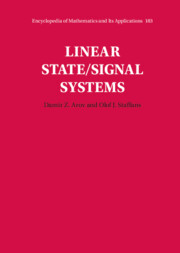Book contents
- Frontmatter
- Contents
- Preface
- Notations
- 1 Introduction and Overview
- 2 State/Signal Systems: Trajectories, Transformations, and Interconnections
- 3 State/Signal Systems: Dynamic and Frequency Domain Properties
- 4 Input/State/Output Representations
- 5 Input/State/Output Systems: Dynamic and Frequency Domain Properties
- 6 Bounded Input/State/Output Systems in Continuous and Discrete Time
- 7 Bounded Input/State/Output Systems in Continuous and Discrete Time
- 8 Semi-bounded Input/State/Output Systems
- 9 Semi-bounded State/Signal Systems
- 10 Resolvable Input/State/Output and State/Signal Nodes
- 11 Frequency Domain Input/State/Output Systems
- 12 Frequency Domain State/Signal Systems
- 13 Internally Well-Posed Systems
- 14 Well-Posed Input/State/Output Systems
- 15 Well-Posed State/Signal Systems
- Appendix A Operators and Analytic Vector Bundles in H-Spaces
- References
- Index
8 - Semi-bounded Input/State/Output Systems
Published online by Cambridge University Press: 05 May 2022
- Frontmatter
- Contents
- Preface
- Notations
- 1 Introduction and Overview
- 2 State/Signal Systems: Trajectories, Transformations, and Interconnections
- 3 State/Signal Systems: Dynamic and Frequency Domain Properties
- 4 Input/State/Output Representations
- 5 Input/State/Output Systems: Dynamic and Frequency Domain Properties
- 6 Bounded Input/State/Output Systems in Continuous and Discrete Time
- 7 Bounded Input/State/Output Systems in Continuous and Discrete Time
- 8 Semi-bounded Input/State/Output Systems
- 9 Semi-bounded State/Signal Systems
- 10 Resolvable Input/State/Output and State/Signal Nodes
- 11 Frequency Domain Input/State/Output Systems
- 12 Frequency Domain State/Signal Systems
- 13 Internally Well-Posed Systems
- 14 Well-Posed Input/State/Output Systems
- 15 Well-Posed State/Signal Systems
- Appendix A Operators and Analytic Vector Bundles in H-Spaces
- References
- Index
Summary
Chapter 8 concludes the book by proposing ways to improve decision-making in relation to sharing linked data for research. It considers improvements in a number of areas: the decision-making framework of interests, values, and rights; the decision-making criteria and conditions; the decision makers who are best placed to make each decision; and the decision-making process. The chapter sets out the interests, values and rights that should frame decisions in this sphere, not all of which are currently represented in decision-making frameworks. It provides a list of decision-making criteria and considerations that should be taken into consideration by the relevant decision makers. The chapter distinguishes between ethical decisions, which should be made by ethics committees and governance decisions, which should be made data custodians. Finally, the chapter makes recommendations for a decision-making process that will be efficient, transparent, accountable and collaborative. This process is designed to lead to better decisions and to ensure that both the decision-making process and the decisions themselves develop and sustain the social licence needed to support the important enterprise of research using linked data.
Keywords
- Type
- Chapter
- Information
- Linear State/Signal Systems , pp. 521 - 575Publisher: Cambridge University PressPrint publication year: 2022

